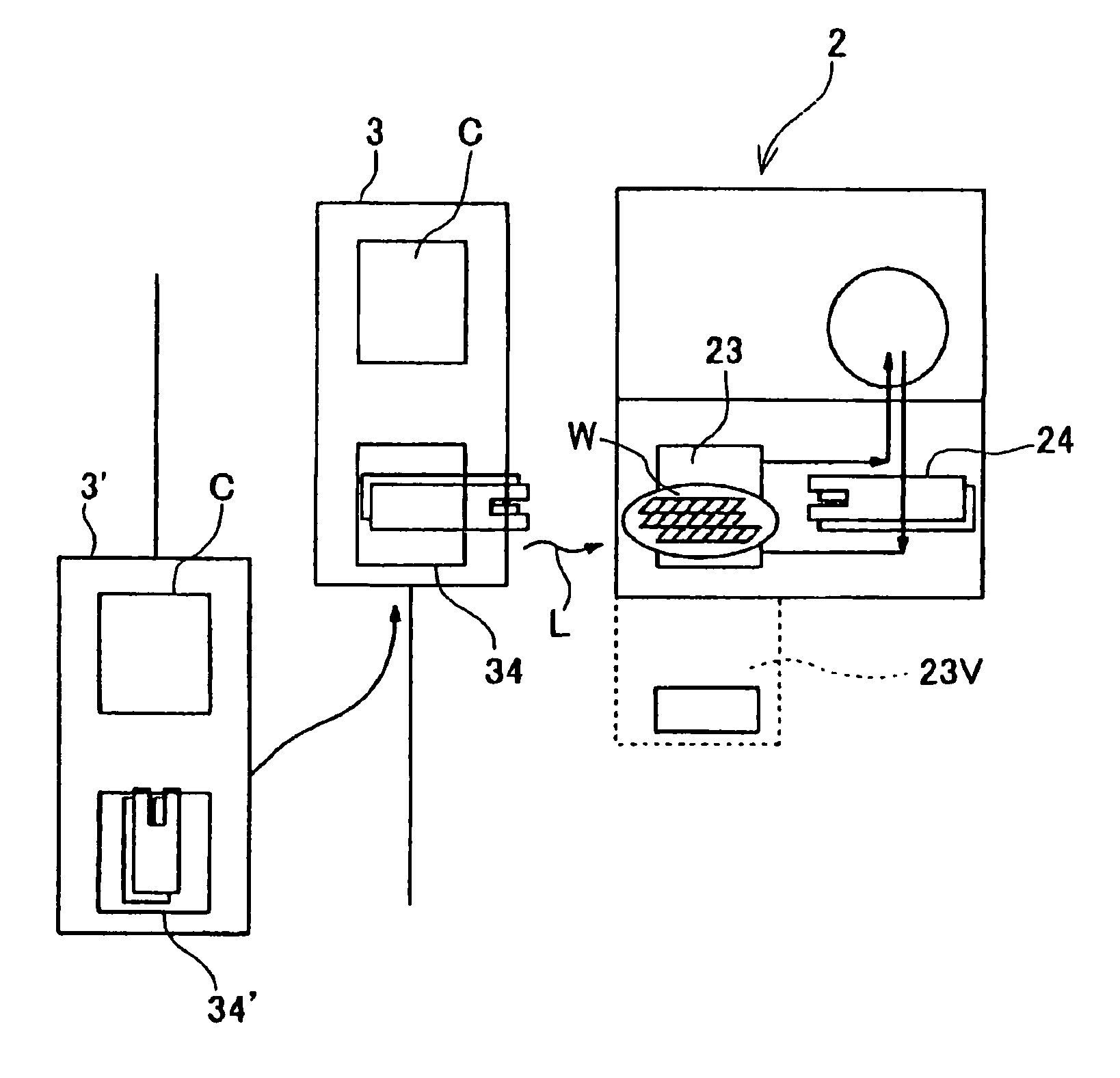However, if a wafer to be inspected has a large
diameter of, for example, 300 mm, it becomes almost impossible for an operator to
handle a carrier having a plurality of such wafers because the carrier is remarkably heavy.
Even if the operator can
handle the carrier, the operator's carrying alone may be accompanied with a risk.
Further, since the management about particles in a clean room has become severe with the hyperfineness of semiconductor devices, the automatization of manufacturing installations, such as carrier conveyer, is taking on importance increasingly in view of managing particles in the clean room.
Additionally, due to the large-
diameter and hyperfineness of a wafer, there is a jump in the number of devices to be formed in a single wafer, requiring a long period for completing a process, such as inspection, for one wafer.
Moreover, to process wafers in lot unit would cause the wafers after
processing to stay in a prober until the
processing operation will be completed in all of the wafers in the lot, thereby delaying a time for feeding the wafers in lot unit to a sequent process.
Consequently, it becomes difficult to shorten TAT (Turn-Around-Time) in the production.
On the other hand, since there is a recent tendency that the carrier becomes heavy for the wafers having large diameters thereby making it difficult and risky for an operator to
handle such a carrier, Japanese Patent Publication (kokai) No. 10-303270 proposes a conveyance method that employs an
automated guided vehicle (which will be referred as "AGV" after) to transport the carrier thereby to allow wafers in the same lot to be delivered between the vehicle and an process installation, in carrier unit.
However, if one carrier is present in the semiconductor manufacturing device having the only load port, the next carrier cannot be loaded unless the previous carrier is unloaded from the
semiconductor device as a result of completion of processing all the objects in this carrier.
Thus, the operation for processing the objects comes to a standstill during loading and unloading the carrier, so that an improvement in the
throughput of the system cannot be expected.
While, if establishing new load ports in the
semiconductor device, then a problem arises in the increase in
footprint and also manufacturing cost.
Furthermore, in the situation such that the carrier becomes heavy for the wafers having large diameters thereby making it difficult and risky for an operator to handle such a carrier, Japanese Patent Publication (kokai) No. 10-303270 proposes the conveyance method that employs the
automated guided vehicle (which will be referred as "AGV" after) to transport the carrier thereby to allow wafers in the same lot to be delivered between the vehicle and an process installation, in carrier unit.
However, due to the large-
diameter and hyperfineness of a wafer, there is a jump in the number of devices to be formed in a single wafer, requiring a long period for completing various processing, such as inspection, for one single wafer.
Therefore, even if the wafers in the same lot could be transported to a semiconductor manufacturing device, such as inspecting device, in carrier unit by the AGV, the processing of wafers in lot unit would require considerable date and time while causing even the wafers after processing to stay in the semiconductor manufacturing device.
Consequently, the time to feed the wafers in lot unit to a sequent process is delayed to that extent, so that it becomes difficult to shorten TAT (Turn-Around-Time) in the production.
Therefore, there are problems that it takes a lot of time for centering a wafer and a lot of cost for the optical sensor for this centering.
Further, if a wafer to be inspected has a large diameter of, for example, 300 mm, it becomes almost impossible for an operator to handle a carrier having a plurality of such wafers because the carrier is remarkably heavy.
Even if the operator can handle the carrier, the operator's carrying alone may be accompanied with a risk.
However, due to the large-diameter and hyperfineness of a wafer, there is a jump in the number of devices to be formed in a single wafer, requiring a long period for completing an inspection of one wafer.
Moreover, the inspection of wafers in lot unit would cause the wafers after inspecting to stay in a prober (carrier) until the inspection of all of the wafers in the lot is completed, thereby delaying a time for feeding the wafers in lot unit to a sequent process.
Consequently, it becomes difficult to shorten TAT (Turn-Around-Time) in the production.
However, since there exists a limitation in the
power capacity of a battery forming a drive source for the compressor,
on board of the AGV, it is impossible to assure a sufficient flow rate of
exhaust gas necessary for the vacuum absorption.
 Login to View More
Login to View More  Login to View More
Login to View More 


